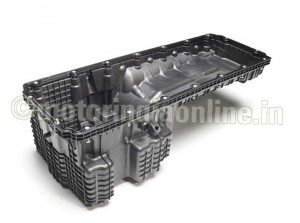
Oil pans fitted in the 12.8 litre Euro 6 engines for the Mercedes Actros from Daimler are up to 120 cm long, 40 cm wide and 35 cm deep. To date, they are the largest engine oil pans for trucks to be made of polyamide 6 and 66. They are manufactured by Marbach-based BBP Kunststoffwerk Marbach Baier GmbH using Durethan from LANXESS.
“We used a series of calculations and simulations to confirm the feasibility of the oil pans in advance, thus helping to ensure that the pans could be designed on the computer properly and cost-effectively over a relatively short development period,” explained Frank Krause, a LANXESS expert for oil-carrying engine parts made of plastic.
An alternative to aluminum, sheet steel and SMC
In this particular application, polyamide offers an alternative to aluminum, sheet steel and sheet molding compounds (SMC). It produces far lighter components than die-cast aluminum, for example. What’s more, polyamide components made using injection molding processes are ready for use straightaway. In contrast, die-cast and SMC parts often have to undergo laborious and costly additional processing in order to remove burring, for example.
One variant of the oil pan for the 12.8 litre engine is made of the heat-stabilized polyamide 66 Durethan AKV 35 H2.0 filled with 35 per cent glass fibers, while the other is manufactured using the corresponding polyamide 6 grade Durethan BKV 35 EF H2.0.
Durethan BKV 35 EF H2.0 offers an additional advantage, as its glass fibers are less prominent on the surface. This ensures a high degree of tightness in the groove areas and improved removal from the mold.
During the development of the oil pans, LANXESS provided its partners with comprehensive support in the form of calculations and simulations. This included structural optimization to improve the acoustic behavior of the pans, and a simulation exercise to examine resistance to stone chippings and deformation on exposure to sealing force.
Simulations were also carried out for the filling of the injection molds and the distortion behavior of the oil pans. “These calculations helped us to ensure the molds were filled evenly, particularly in the flange area, thus minimizing distortion,” Krause explained.
Speaking of the Indian prospects, Ms. Sushmita Datta – Business Unit Head (India), High Performance Materials, observed: “The commercial vehicle market is changing rapidly in India. There is a visible difference in the technology used in the past to those being used in the present. The commercial vehicles have evolved to be more advanced in terms of technology, enhanced quality and performance. Understanding the growth potential of the commercial vehicle industry, many multinational companies like Volvo, Daimler, Scania, MAN, etc., are very active and taking the opportunity to tap the potential and establish their market position in India. This will certainly result in an increase in demand for high performance materials and its applications for the commercial vehicle sector.”